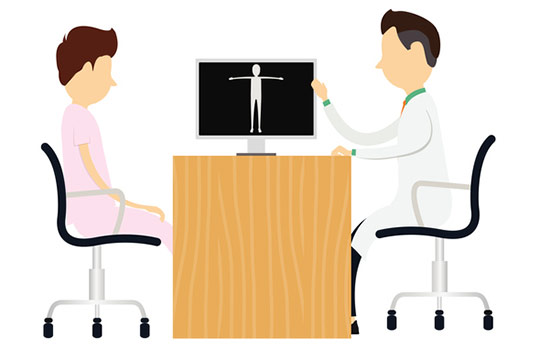Patient inclusion is rightly becoming more accepted, but a doctor’s opinion is often valued
 Inclusion is a hot commodity these days. The right to be included in various aspects of society is fought over in the streets and courtrooms. From eruptive violence at protests to the quiet multitude of signatures on a petition, the desire and right to be included is a flashpoint for many. It fills our newspaper pages, television screens, and social media, and is debated behind closed doors. It exists on many levels and takes many forms.
Inclusion is a hot commodity these days. The right to be included in various aspects of society is fought over in the streets and courtrooms. From eruptive violence at protests to the quiet multitude of signatures on a petition, the desire and right to be included is a flashpoint for many. It fills our newspaper pages, television screens, and social media, and is debated behind closed doors. It exists on many levels and takes many forms.
In a dim corner, sits patient inclusion. Steadily growing, this movement is becoming visible to more doctors and healthcare workers with open minds, eyes, and the compassion to recognise it. Yet it’s still unseen by many.
The simplest level of inclusion can be physical presence. It is becoming increasingly common for couples to attend each other’s appointments and more. My husband does not have a healthy heart. Having watched him be cardioverted three successive times because he would not agree to it unless I stayed with him is a rite of passage that opens new doors. The A&E doctor who first allowed me to stay had opened her eyes, saw his need for me to remain, and acted on it. Her willingness to step outside the boundaries of convention was an act of remarkable kindness to my husband.
While some doctors may forbid my presence, they underestimate the deep well of strength that can be drawn from it, as well as the heightened anxiety excluding me would have caused for both of us. It should not be inferred that I need protection for my own sake because I am not a doctor. Unfortunately, the first cardiologist he saw after this obviously did not like my presence in the room, and steadfastly refused to examine him with me there. It was the first and last visit with that doctor.
The cardiologist that he now sees also recognised the need for my inclusion. Granted permission to be present for my husband’s stress test, I sat quietly out of the way, only speaking when spoken to, riding the jagged waves of my husband’s heart rate on the monitor. After the cardiologist had called an early end to the stress test (thankfully), as my husband sat on the gurney waiting for his rhythm to return to normal, he turned to me and said, “I did it for you, dear.” The cardiologist got what he wanted and so did my husband because of my inclusion, as unorthodox as it may seem. (Although to this day, I think the doctor believes it is my need and not my husband’s for me to be there.)
I too have experienced the benefits of being actively involved in my own healthcare. One of my specialists sat down with me to review the results of a recent blood test. She explained what each group of tests were for and gave me a copy to take home. Thanks to this simple, yet powerful approach of inclusion, education, and an extra few minutes of time, I now have a better understanding of blood work. She removed some of the mystery and anxiety.
Like many other people, I am happy to see an end to the paternalistic approach to healthcare, but there are also clear signs of hazards from my perspective. Has the pendulum swung too far and at times become out of sync with patients’ peace of mind?
As an example, more and more, patients are being included when choosing their medications. Yet when you’re left alone to decide this can be an intimidating and stressful task. Once, I was given a diagnosis, the names of three medications to help treat it, and told to choose one. I was at a loss. Since I’d never heard of these drugs or their class, I asked for guidance, but it was refused. The reply being, “What can I do to help you decide?” Overwhelmed with information and the fear of serious adverse events, I waited for a few months for a referral from a different doctor to get another specialist’s opinion.
Another couple I know had to make a similar decision for a different diagnosis; again, different options were presented to them to decide upon, but they too felt uncomfortable making the choice alone. While reputable websites serve me well for some things, they do not replace expert opinion. I am still a layperson. Is it not in my best interest for doctors to—as a knowledgeable and experienced professional—voice a preference for one of three medications? Try as I might to understand the intricacies of pharmaceuticals, I barely grasp the basics, and expect some guidance when making a decision about a particular medication if I ask for it. The benefits of shared decision making have been widely acknowledged. Yet healthcare should be just that: caring for my health.
Patient inclusion is growing and becoming widely accepted—and that is as it should be. We need to be informed and to feel a part of our own medical care and management. But sometimes we may also feel ill-equipped to make decisions by ourselves, and being overwhelmed by the unknown adds another dimension of anxiety to a diagnosis. Surely, if asked the prescribing physician can recommend one medication to another based on the drugs’ efficacy and their expertise and knowledge. I value that opinion.
The practice of paternalistic medicine is changing, however, including patients should not be at the cost of excluding doctors. A balance must be found. It is my right to be included; but it is also my right to include my doctor, and to receive guidance if I ask for it, and that is worth fighting for.
Sharon Roman studied economics at the University of Toronto and Simon Fraser University. She had her first MS attack around the age of 30. Twitter @SRoman_SPQR
Competing interests: None declared.
